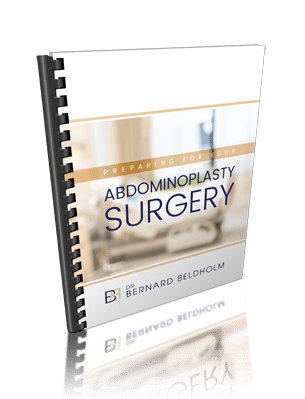Abdominoplasty is a procedure designed to remove excess skin and fat from the abdominal area while tightening the underlying muscles. Highly requested by many of my patients, I created this primer to serve as a complete guide for anyone who’s interested in undergoing the procedure.
This Article Will:
- Explain abdominoplasty surgery
- Define who is a good candidate for the procedure
- Explain the various reasons to consider abdominoplasty
- Illustrate the various types of abdominoplasty procedures
- Identify the benefits of abdominoplasty
- Highlight potential risks and complications
- Go through the preparation steps
- Explain the procedure
- Describe the recovery process
- Discuss cost considerations
Understanding Abdominoplasty
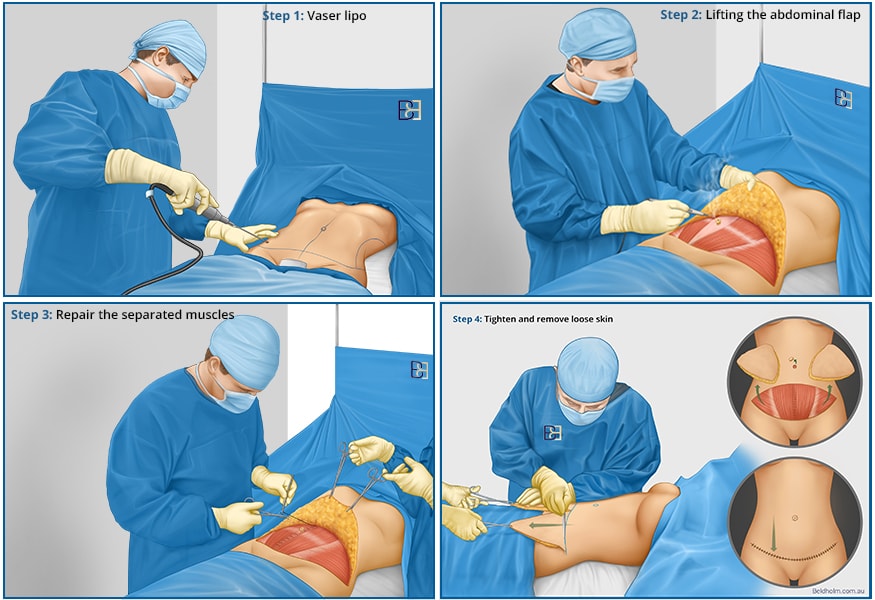
Book your appointment online now
This surgery is often sought after by individuals who have experienced significant weight loss through diet, exercise, or bariatric weight loss surgery, or have recently given birth, and have been left with loose abdominal muscles, stubborn fat pockets, and excessive and loose skin, none of which have responded to traditional methods.
Though the primary goal of the group of abdominoplasty surgeries is to focus on aestheticst, the procedures also have benefits beyond appearance.
Who is a Candidate for an Abdominoplasty?
Contrary to popular belief, not everyone is a candidate for abdominoplasty surgery. Ideal candidates are those who have excess skin and fat, as well as weakened abdominal muscles due to factors like pregnancy or significant weight loss. If you’re fit, have maintained a stable weight for at least six months, and have realistic expectations, you may be a good candidate for this procedure.
Three Reasons to Consider Abdominoplasty Surgery
- Loose, Excess skin
- Diastasis recti (Muscle separation)
- Excess subcutaneous fatty tissue
1. Loose, Excess Skin
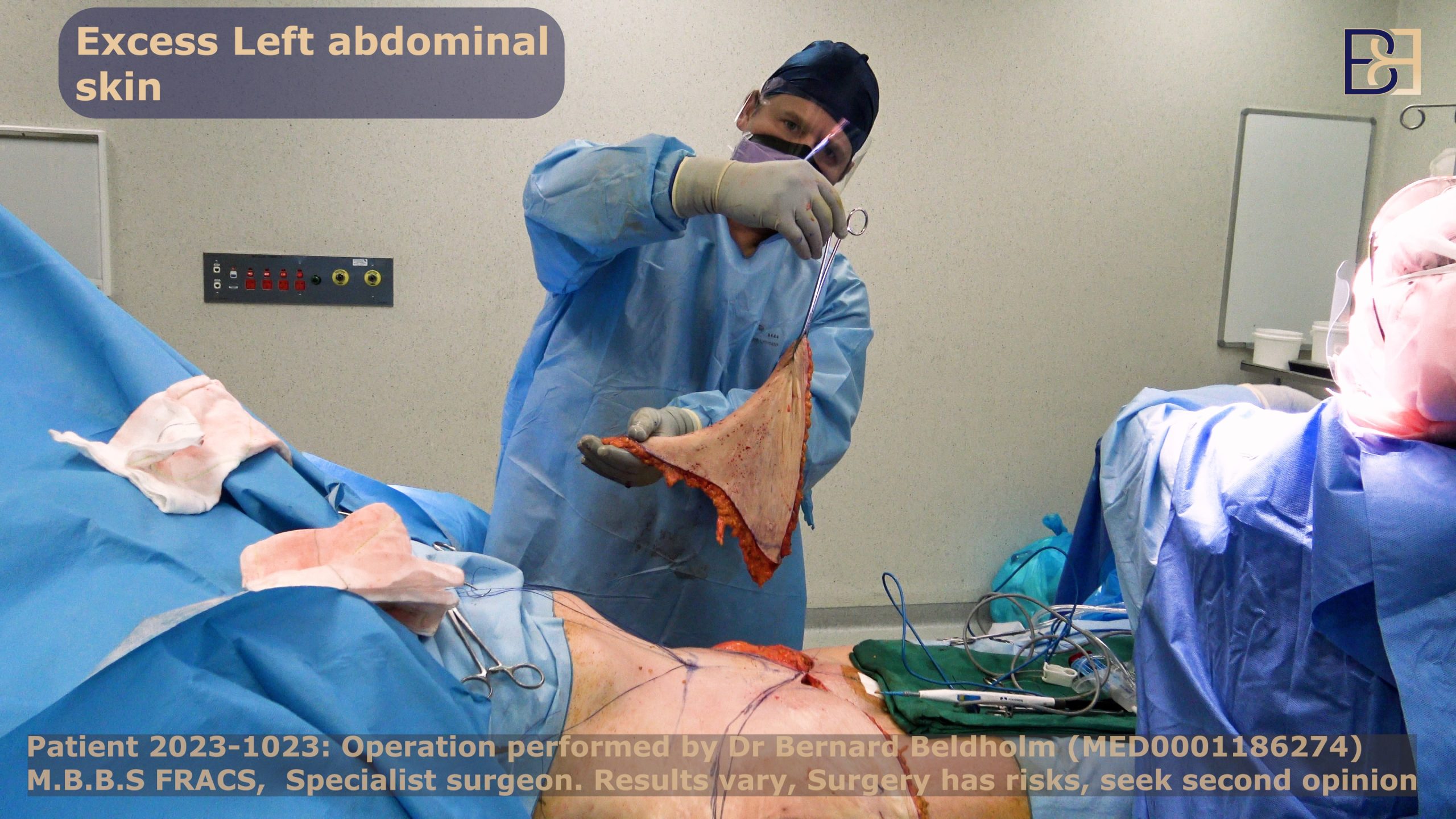
One of the primary indications for abdominoplasty surgery is loose skin, which can occur both after pregnancy and following significant weight loss. During pregnancy, the skin and abdominal muscles stretch to accommodate the growing baby, often resulting in excess skin once the baby is born. The risk for developing loose skin postpartum increases with age and may rise with subsequent pregnancies.
Similarly, individuals who experience substantial weight loss, either through diet and exercise or bariatric surgery, may find themselves with loose, hanging skin that doesn’t retract to their new body size.
It is important to note that abdominoplasty is NOT a substitute for weight loss. Candidates for the procedure must be at or close to their goal weight before undergoing this procedure.
2. Diastasis Recti (Abdominal Muscle Separation)
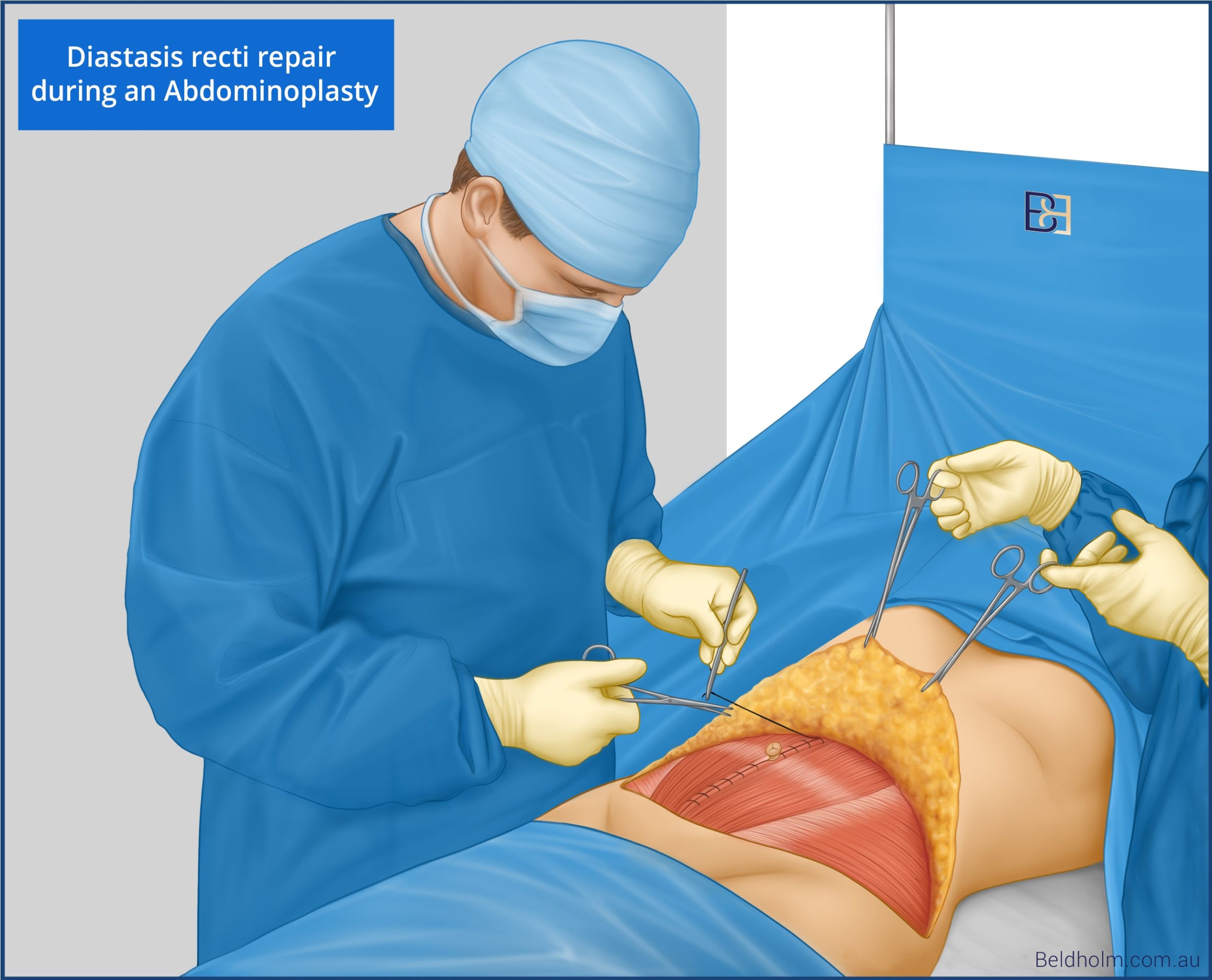
A common condition (experienced by 60% of women during and after pregnancy), abdominal muscle separation, also known as diastasis recti, occurs as the growing baby stretches the abdominal muscles and connective tissue, often leaving a noticeable gap and a protruding belly after childbirth. While exercise and physical therapy can help to some extent, they may not fully resolve the issue.
Diastasis recti can also occur after significant weight loss, following gastric bypass and other types of weight-loss surgery (also called bariatric or metabolic surgery), or through traditional means such as diet and exercise.
Related post: Does Exercise Help Diastasis Recti?
![Abdominoplasty Primer: A Complete Guide 4 Diastasis recti [Operation image] | Dr Beldholm](https://beldholm.com.au/wp-content/uploads/2025/02/c4b22fb4-8635-4b64-a8fa-40259dbce280-scaled-1.jpg)
Abdominoplasty surgery can be an effective solution for repairing diastasis recti. During the procedure, the separated muscles are brought back together and stitched into place, creating a tighter and more stable abdominal wall. Not only does this elevate the appearance of the abdomen, but the core may stregnthened, stability may be increased, and back pain commonly associated with weak abdominal muscles may be reduced or prevented.
3. Fat Deposits (Adipose tissue)

For patients looking to maximise the results of their abdominoplasty, combining abdominoplasty with suction-assisted lipectomy (liposuction) can help. An approach, known as lipo-abdominoplasty, combines the benefits of abdominoplasty with the fat-removing capabilities of suction-assisted lipectomy (liposuction), eliminating the need for two separate procedures.
Preparing for an Abdominoplasty
Preparation is a key component of a successful abdominoplasty experience. This includes following pre-surgery instructions including dietary restrictions, quitting smoking, and medication instructions, all of which play an essential role ensuring a smooth procedure, comfortable recovery, and a successful outcome.
Check out my comprehensive article on preparing for abdominoplasty: “Top Tips for Preparing for Your Abdominoplasty”.
Types of Abdominoplasty
Abdominoplasty can be classified into various types, each tailored to meet specific needs.
- Mini Abdominoplasty
- Full Abdominoplasty
- Extended Abdominoplasty
- FDL (Fleur-de-Lis) Abdominoplasty
- Body Lift( Belt Lipectomy)
- Abdominoplasty with suction-assisted lipectomy (liposuction)
Mini Abdominoplasty
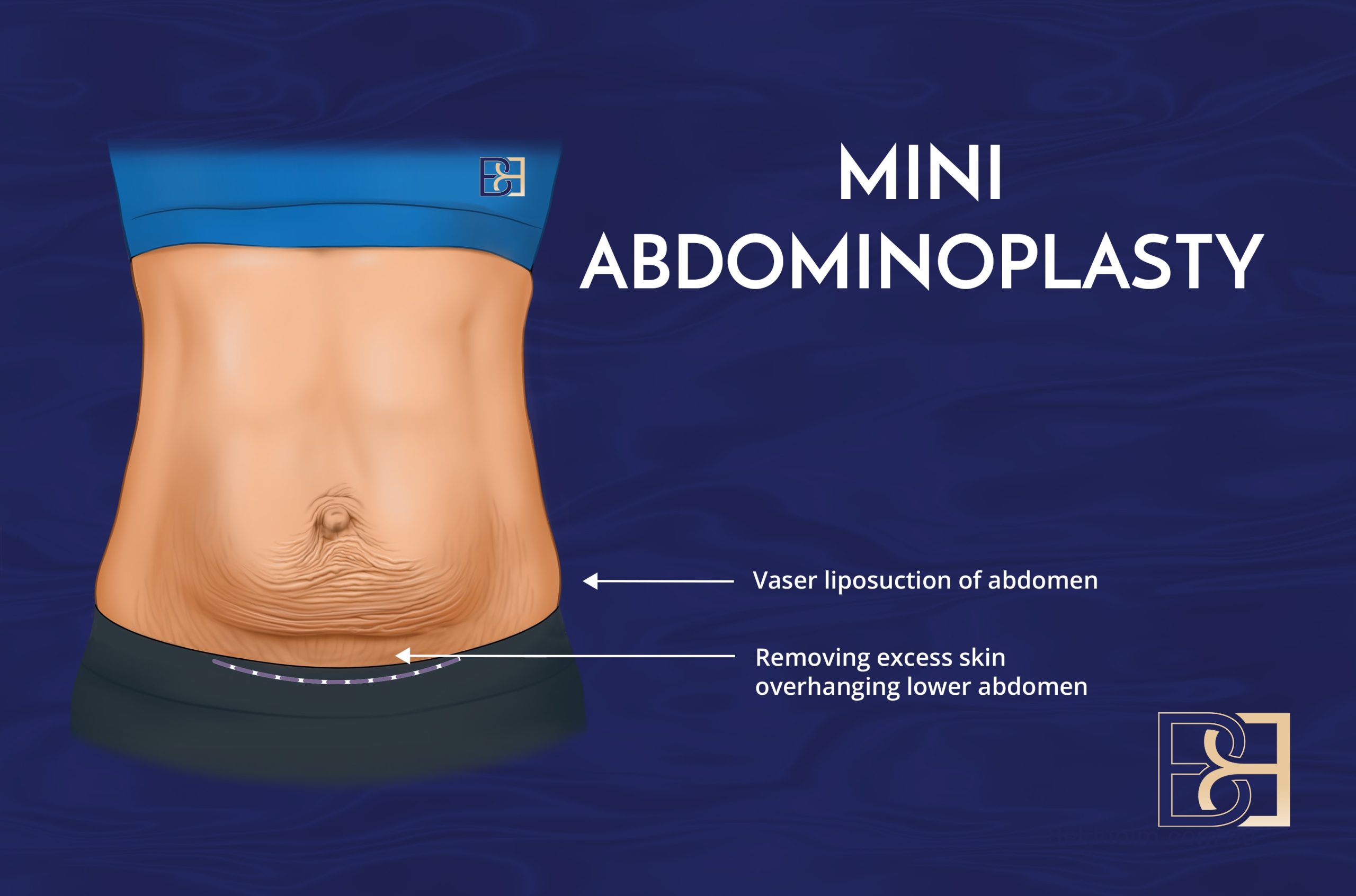
A mini abdominoplasty might be the most suitable option for patients with minimal excess skin and fat. This procedure focuses solely on the lower abdomen, making it less invasive than a full abdominoplasty, it’s ideal for individuals who are generally in good shape but have a small amount of loose skin and fat below the belly button.
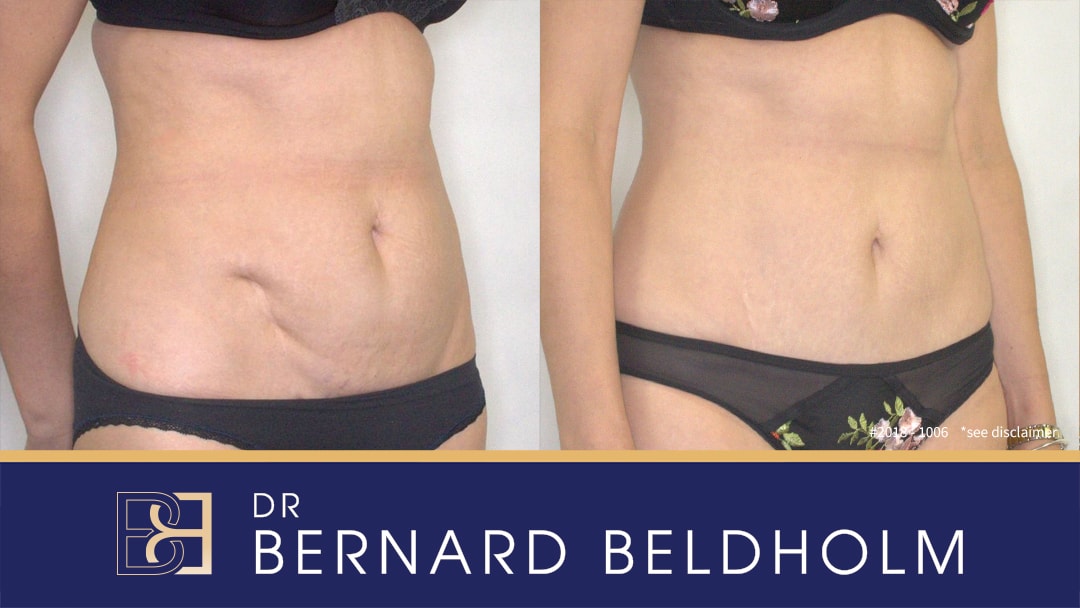
Disclaimer: Operation performed by Dr Bernard Beldholm. Adult content: surgery has risks; individual results vary. Seek a second opinion. Please see the full disclaimer.
A mini abdominoplasty involves a smaller incision and typically results in a timely recovery time and minimal scarring. This procedure is also designed to treat minor cases of muscle separation, focusing on the area below the belly button.
Read more: 15 Important Mini Abdominoplasty Facts You Must Know Today.
Full Abdominoplasty Surgery
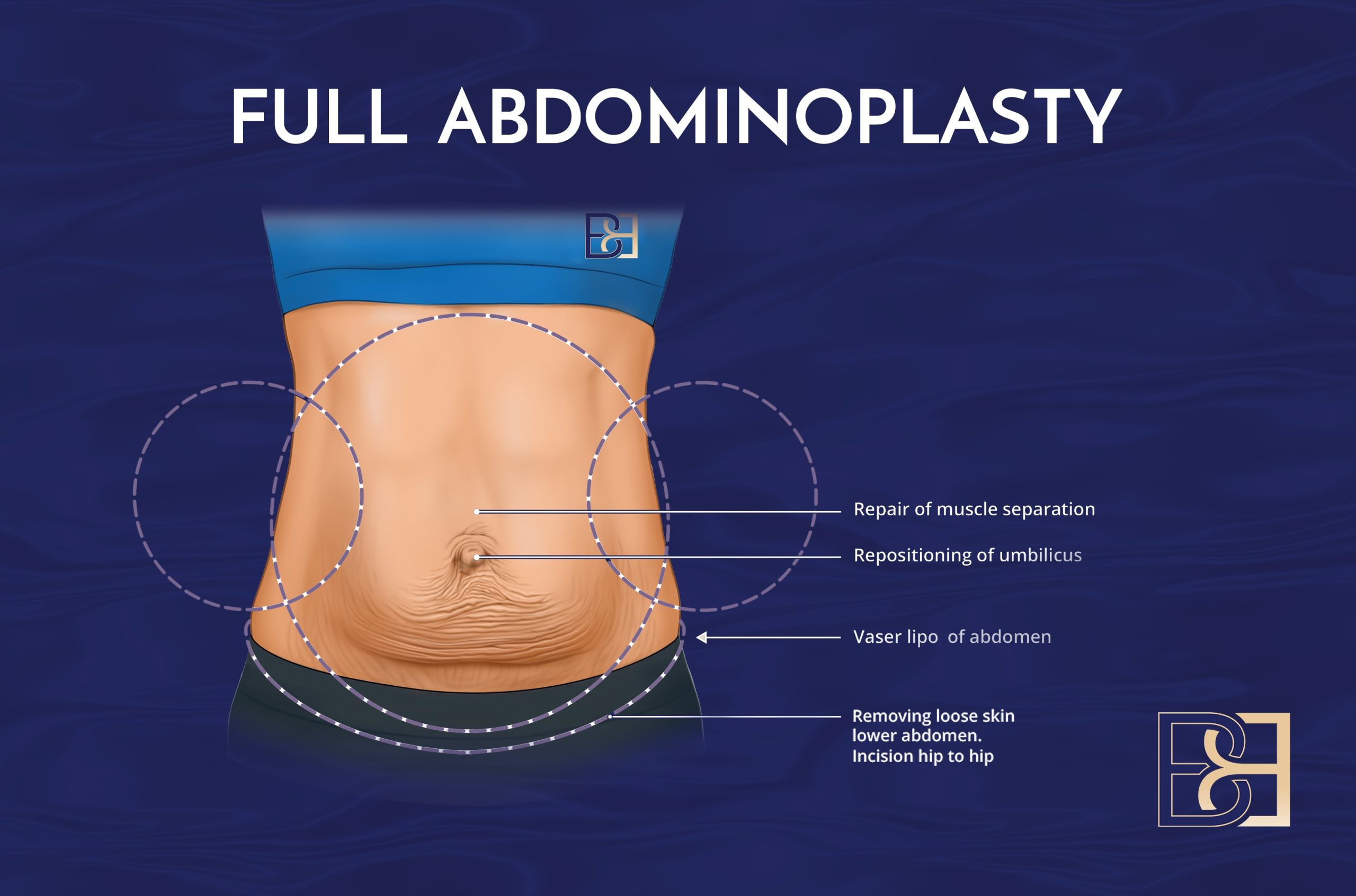
A full abdominoplasty is a more extensive procedure, requiring a larger incision extending from hip to hip. This type of surgery is commonly performed to treat post-pregnancy changes such as muscle separation and loose skin.

Disclaimer: Operation performed by Dr Bernard Beldholm. Adult content, surgery has risks; individual results vary, seek 2nd opinion. Please see the full disclaimer.
During a full abdominoplasty, the horizontal incision across the lower abdomen allows for the removal of excess skin, tightening of abdominal muscles, and repositioning of the umbilicus (belly button.) This type of abdominoplasty, which is particularly beneficial for those dealing with more severe muscle separation, involves a more intensive recovery process. Though patients should expect longer downtime and more visible abdominoplasty scarring, the results can be life-changing, offering a significantly firmer and flatter abdomen.
Read more: “Dr. Beldholm’s Modern Approach to “Drainless” Lipo-Abdominoplasty”
Extended Abdominoplasty Surgery
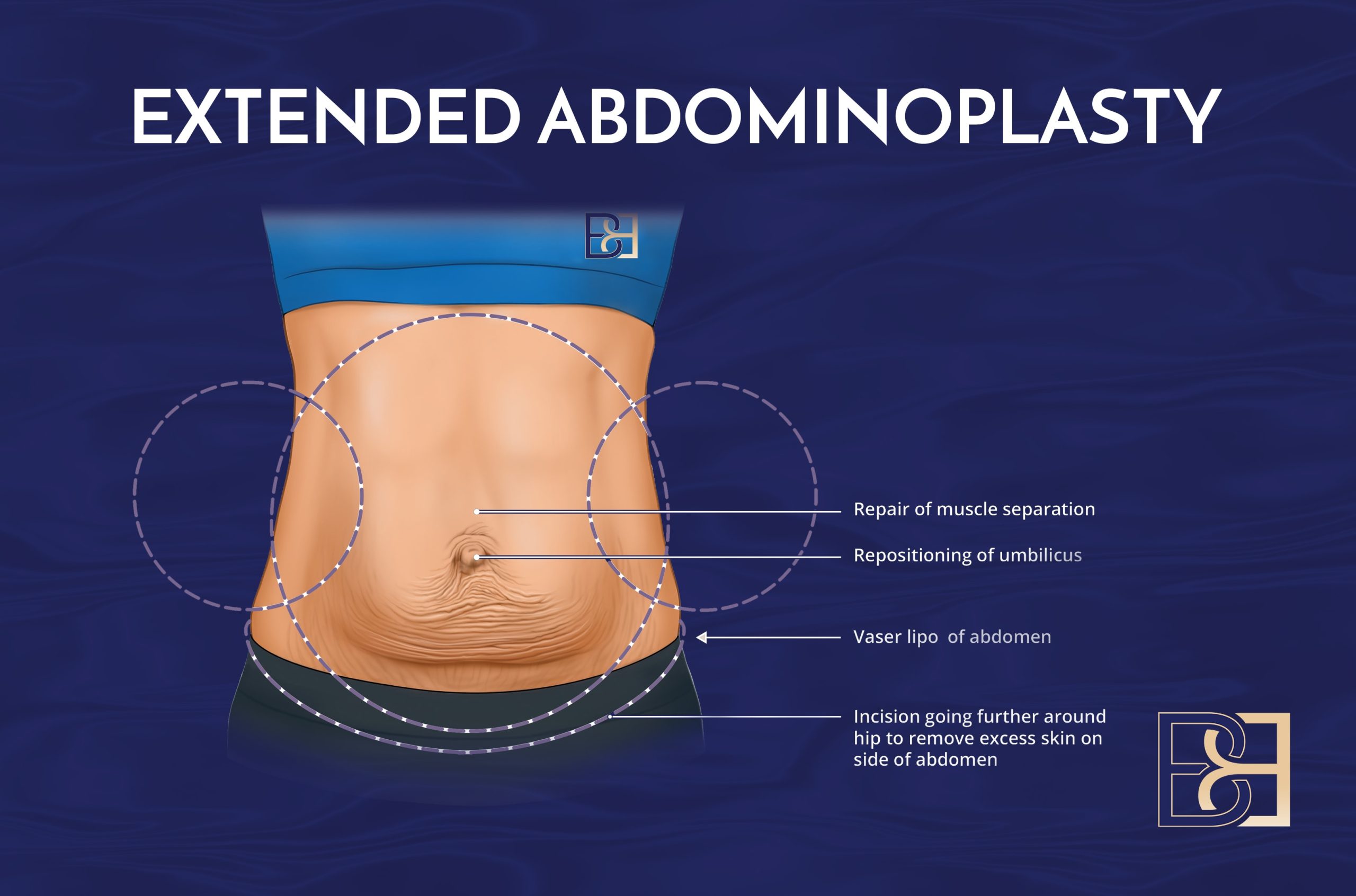
Designed for individuals with significant excess skin and fat not only in the abdomen but also around the flanks and lower back, an extended abdominoplasty requires a longer incision, which allows the surgeon to treat more extensive areas of skin.
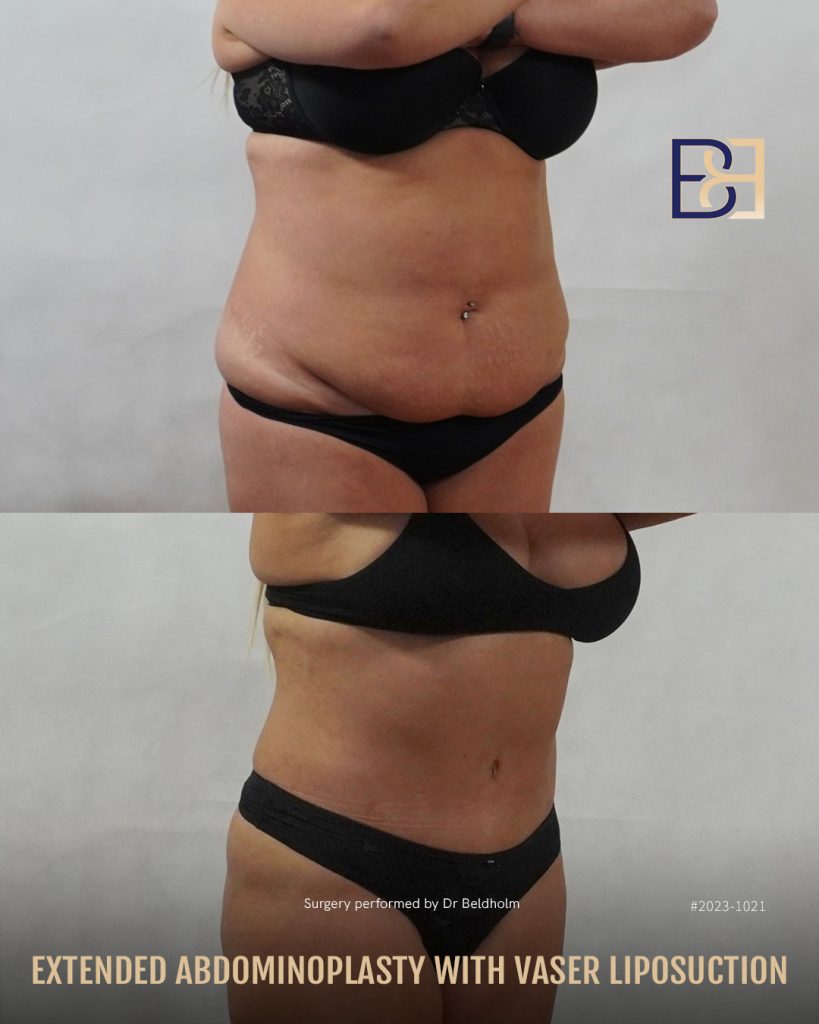
Disclaimer: Operation performed by Dr Bernard Beldholm. Adult content, surgery has risks; individual results vary, seek 2nd opinion. Please see the full disclaimer.
Though the extended abdominoplasty is a more extensive surgical procedure, involving increased scarring and longer downtime, the results can be quite impactful.
Book your appointment online now
Fleur-de-lis Abdominoplasty Surgery
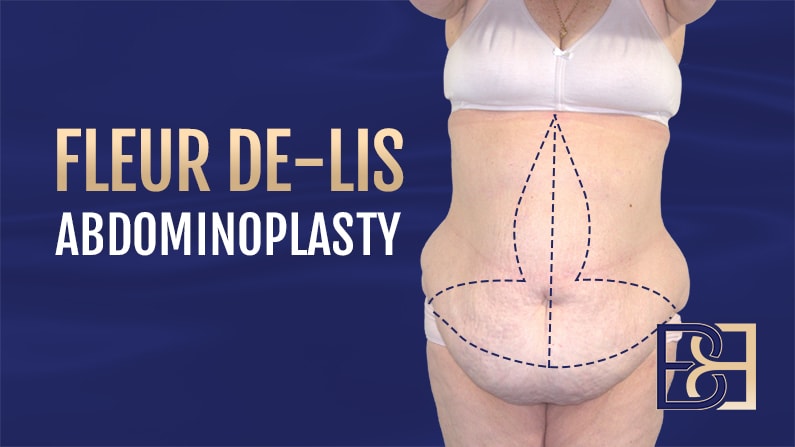
A specialised form of abdominoplasty, the fleur-de-lis abdominoplasty is designed for individuals with significant excess skin and fat, particularly after massive weight loss. Named after the incision’s shape, which resembles an iris flower, this procedure allows for the removal of a larger amount of skin and fat from both the horizontal and vertical planes of the abdomen.
During an FDL abdominoplasty, the surgeon makes a vertical incision from the lower chest down to the pubic area, in addition to the traditional horizontal incision across the lower abdomen. This dual-incision approach enables the removal of excess skin and fat from the upper, middle, and lower abdomen, as well as the flanks. The result is a more comprehensive effect, both vertically and horizontally.
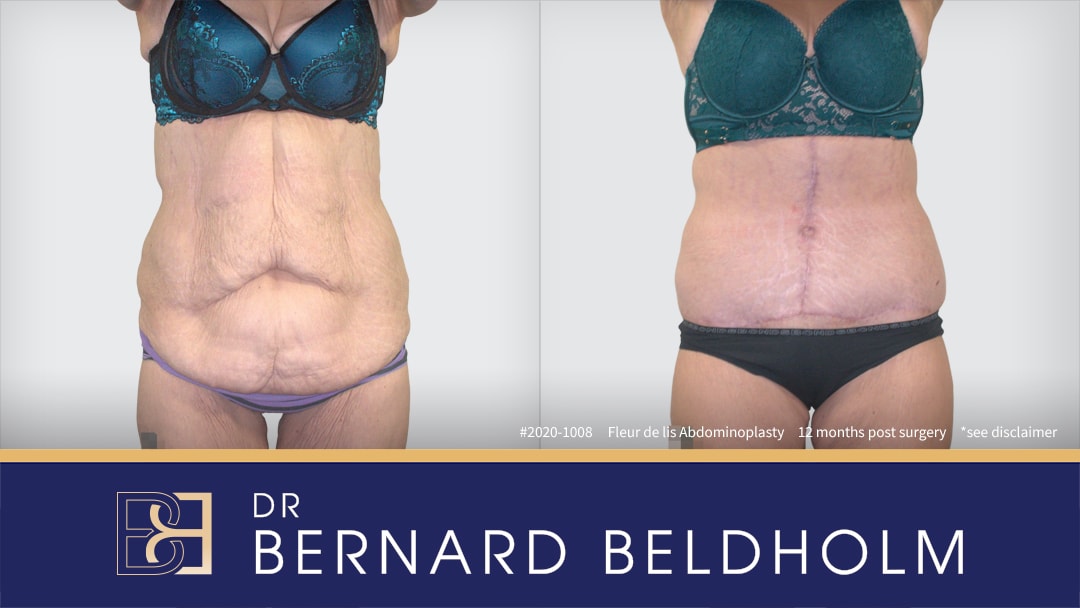
Disclaimer: Operation performed by Dr Bernard Beldholm. Adult content, surgery has risks; individual results vary, seek 2nd opinion. Please see the full disclaimer.
This type of abdominoplasty is particularly beneficial for those who have undergone significant weight loss and have been left with a considerable amount of loose skin that a mini, full or extended abdominoplasty cannot adequately treat.
Due to the more extensive nature of the surgery, however, patients should be prepared for a longer recovery period and more visible vertical and horizontal scars compared to other types of abdominoplasty surgeries.
Read more: “Dr. Beldholm’s Step-by-Step Guide to Fleur-de-Lis Abdominoplasty”.
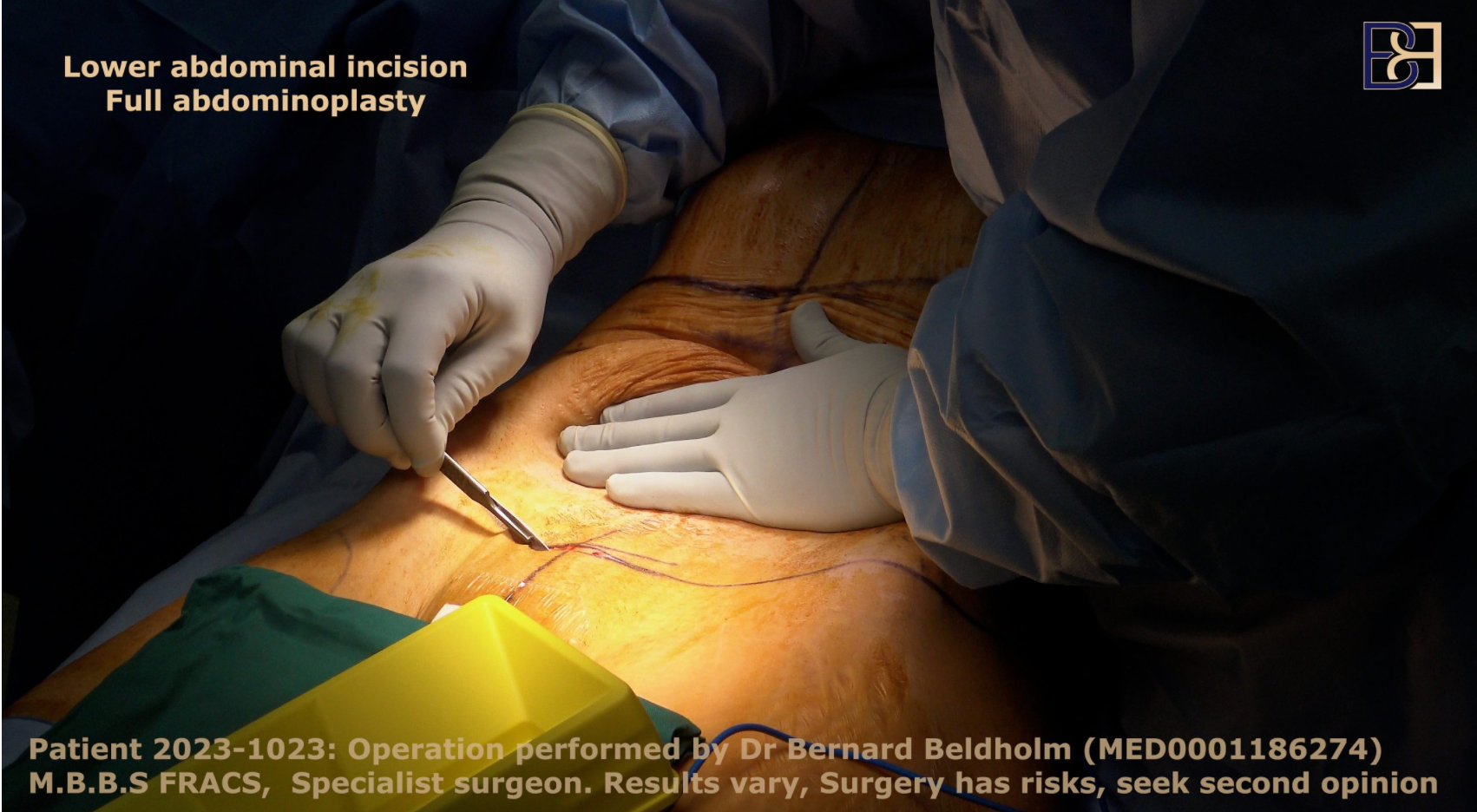
Belt Lipectomy (AKA Body Lift, 360 Body Lift, or Circumferential Abdominoplasty)
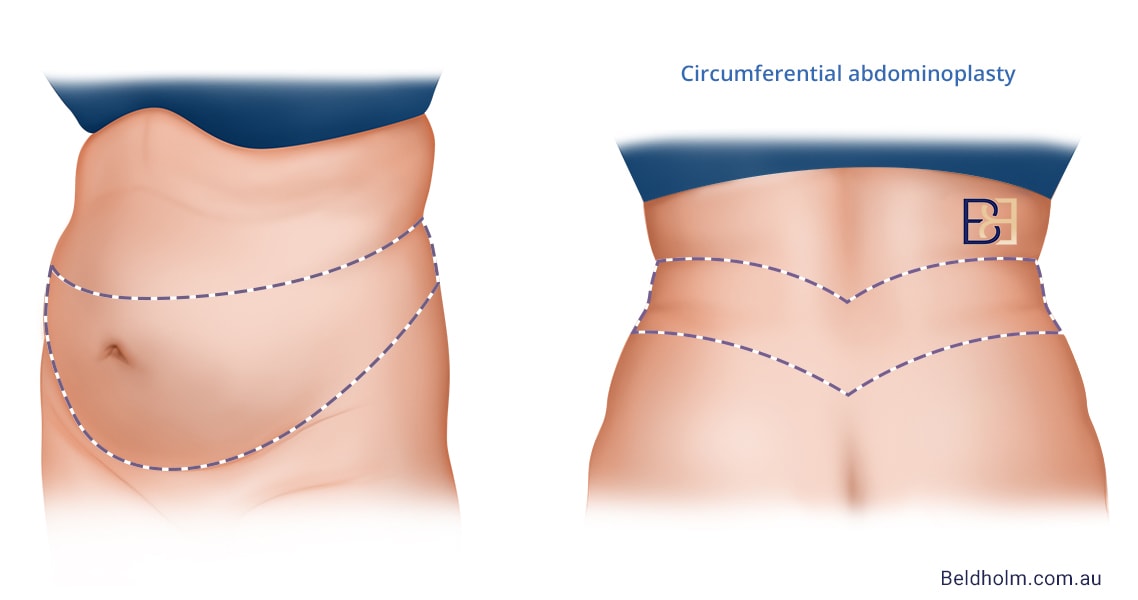
Also known as a body lift or circumferential abdominoplasty, a belt lipectomy targets multiple body areas with excess skin and fat in one or two surgeries. A belt lipectomy is a major operation that achieves quite dramatic results involves the removal of excess skin from the abdomen, hips, pubic area, thighs, and buttocks, commonly following substantial weight loss. By reshaping the entire mid-section, the procedure not only offers aesthetic results, but it also resolves skin irritations and hygienic issues, while increasing comfort and mobility.
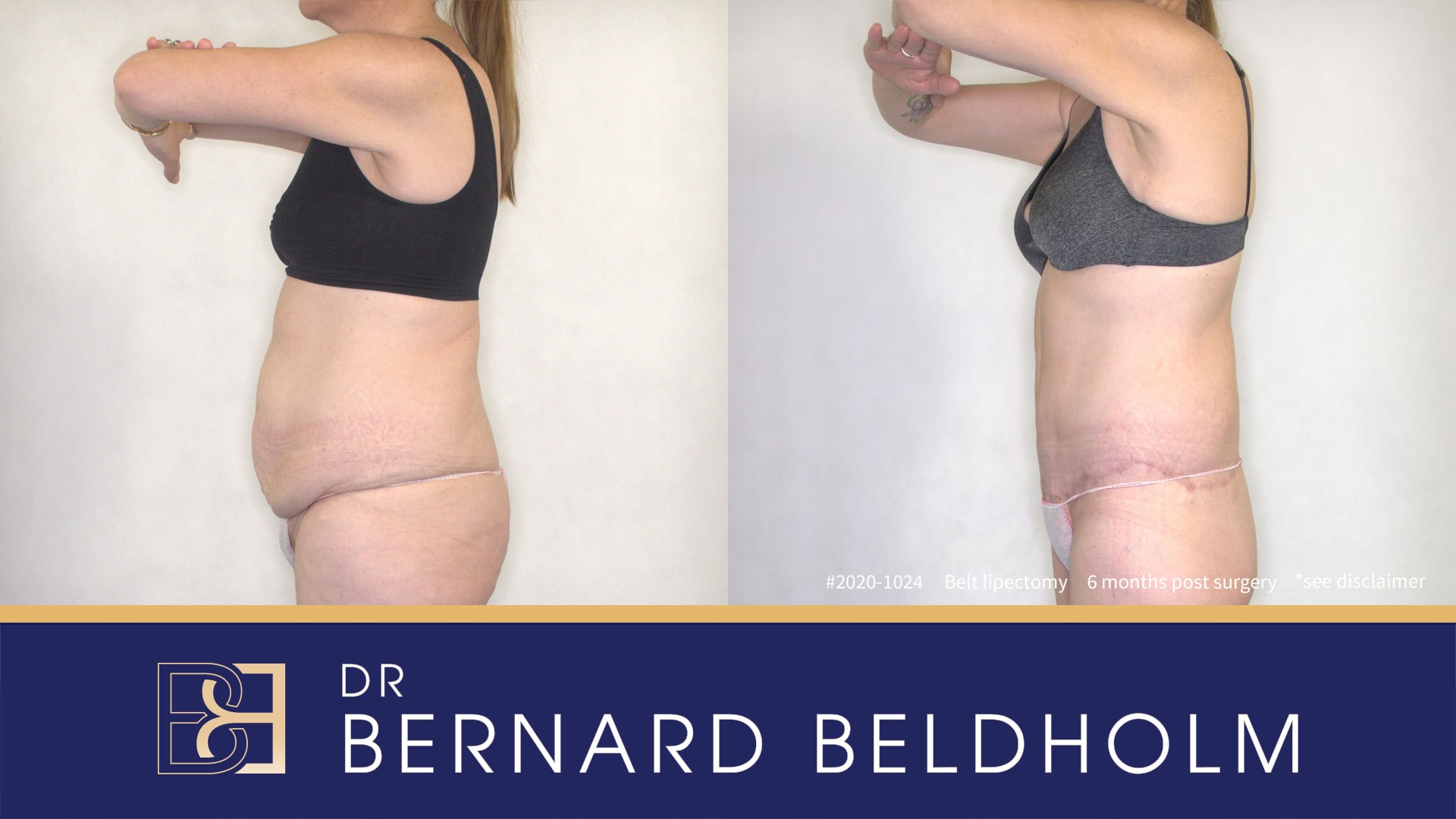
Disclaimer: Operation performed by Dr Bernard Beldholm. Adult content, surgery has risks; individual results vary, seek 2nd opinion. Please see the full disclaimer.
Designed to tighten loose skin on the upper and lower abdomen, mons pubis, hips, lower back, bum, and thighs, and repairing separated abdominal muscles (diastasis recti), all of which are common trouble zones for people who’ve lost massive amounts of weight, a belt lipectomy is the most extreme, extensive, and effective of all abdominoplasty procedures.
Read more: What Happens During a Lower Body Lift Surgery Operation? Belt Lipectomy Surgery Guide.
Combining VASER Liposuction with Abdominoplasty (Lipo-Abdominoplasty)
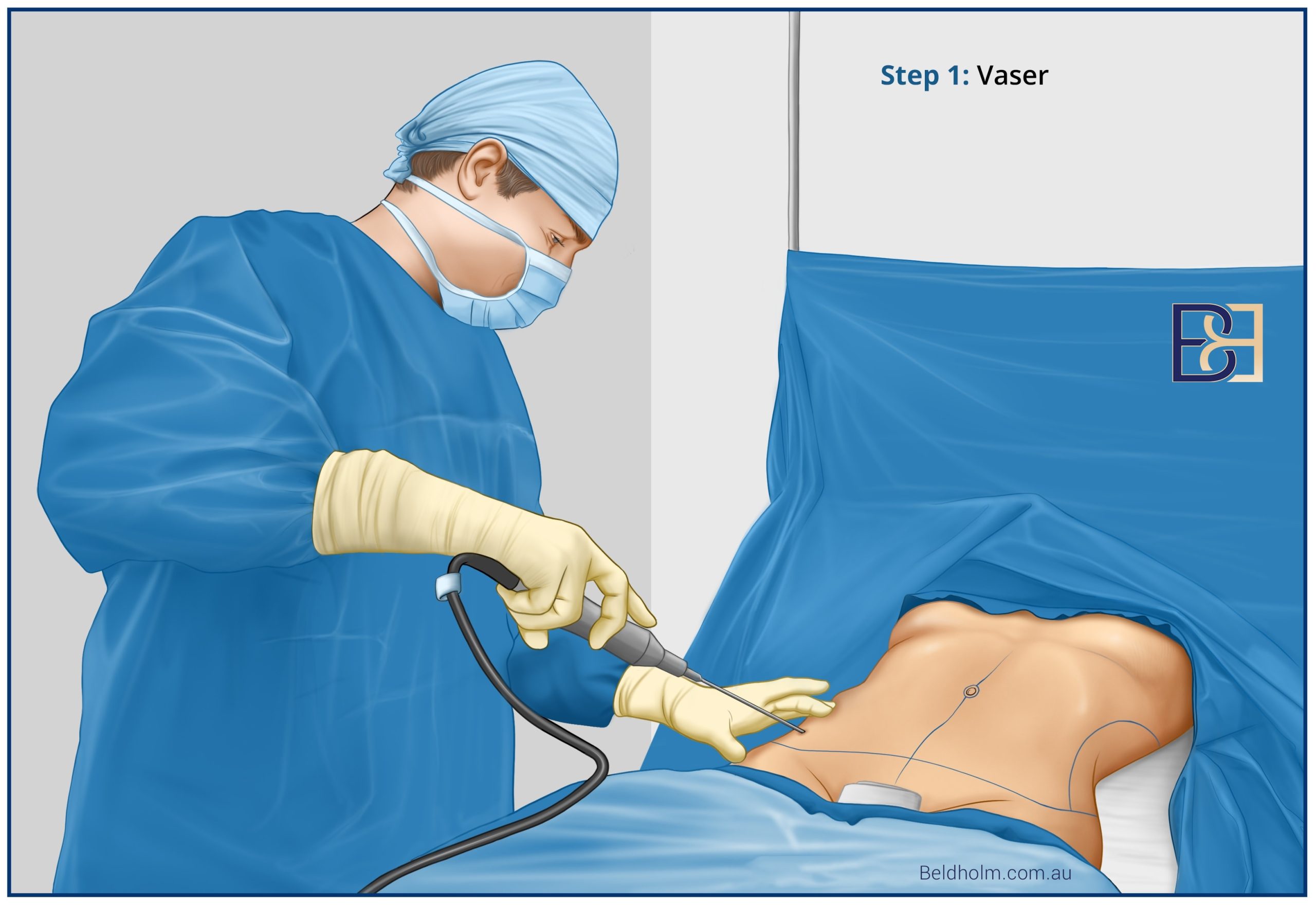
Combining suction-assisted lipectomy (liposuction) with abdominoplasty can he surgical outcome by providing a more contoured and refined appearance. A specialised technique that uses ultrasound technology to break down fat cells, making them easier to remove, VASER (Vibration Amplification of Sound Energy at Resonance) suction-assisted lipectomy (liposuction) is particularly beneficial for targeting fat deposits that do not respond to diet and exercise.
During the procedure, Dr Beldholm first performs VASER suction-assisted lipectomy (liposuction) to liquefy and remove excess fat from the abdomen. The combination of these two procedures can offer optimal results, providing both fat removal and skin tightening in one surgery. Patients who undergo this combined approach often experience a more defined waistline.
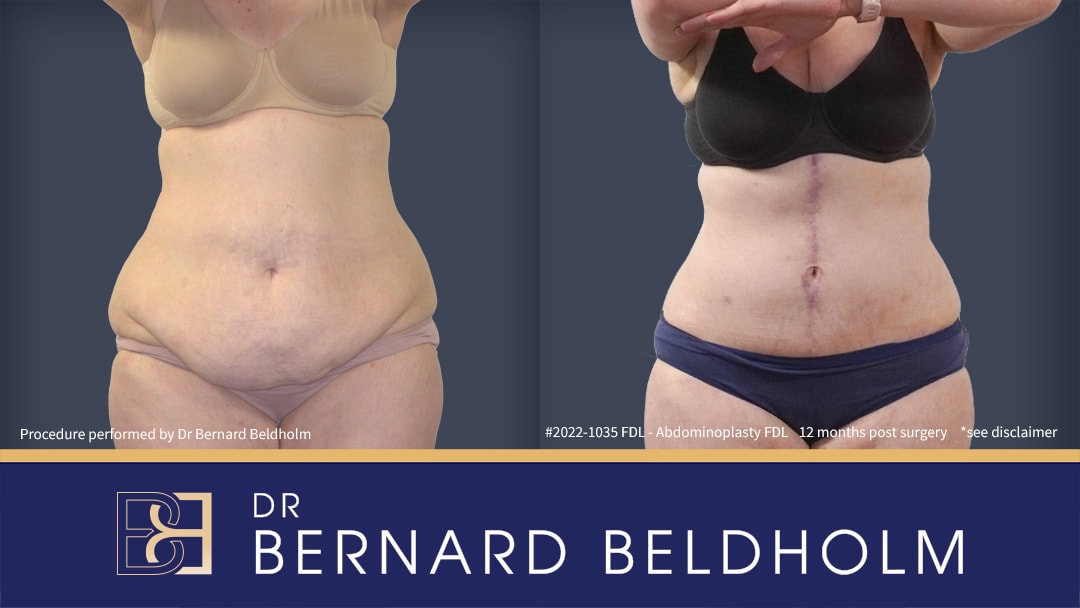
Disclaimer: Operation performed by Dr Bernard Beldholm. Adult content, surgery has risks; individual results vary, seek 2nd opinion. Please see the full disclaimer.
Benefits of Abdominoplasty
Not only does the procedure dramatically reduce significant skin laxity, creating a smoother and firmer profile, but it can also be particularly beneficial for individuals with separated abdominal muscles (diastasis recti). Quite common after pregnancy, repairing these muscles not only optimises the appearance of the abdomen but also focuses on core strength and stability.
Risks and Complications of Abdominoplasty Surgery
Like any major surgery, an Abdominoplasty Surgery comes with its share of risks and potential complications, including the possibility of hypertrophic scars. The estimated rate of serious complications is about 1 in 25 people, which includes infections, blood clots, and healing difficulties that might require further surgery. Minor complications can include haematoma, skin discolouration, and swelling.
Infections and healing issues at the surgical site may lead to the need for skin grafts, and there’s also a risk of deep vein thrombosis, which involves blood clots forming in the legs or lungs. Changes in skin sensations, such as numbness, can also occur and may be temporary or permanent.
Read more “It’s Complicated: The Patient’s Complete Guide to Abdominoplasty Risks“.
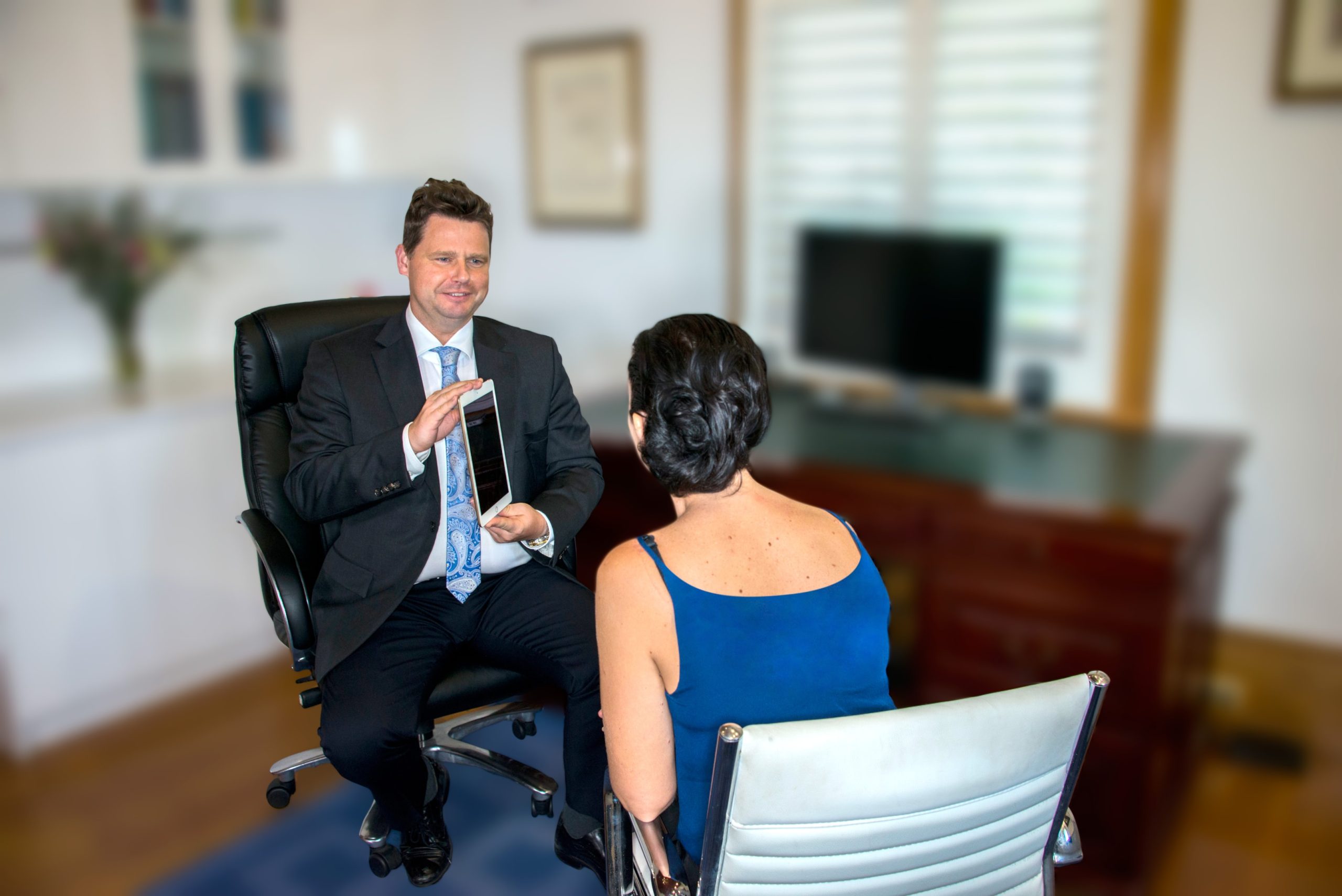
Preparing for Abdominoplasty Surgery
The First Step
Whether you decide to have abdominoplasty for cosmetic or functional concerns (or both), understanding the ins and outs of abdominoplasty is crucial for anyone considering this procedure.
During our consultation, Dr Beldholm will first assess your medical history and current medical status, discuss your goals and expectations, discuss whether you plan to have future pregnancies, and answer all of your questions.
Many times, the final result that you can expect will depend on the right body shape underneath.
I will then make a personalised recommendation as to the procedures that would be most beneficial for you. We will also discuss the potential risks and measures taken to reduce complications.
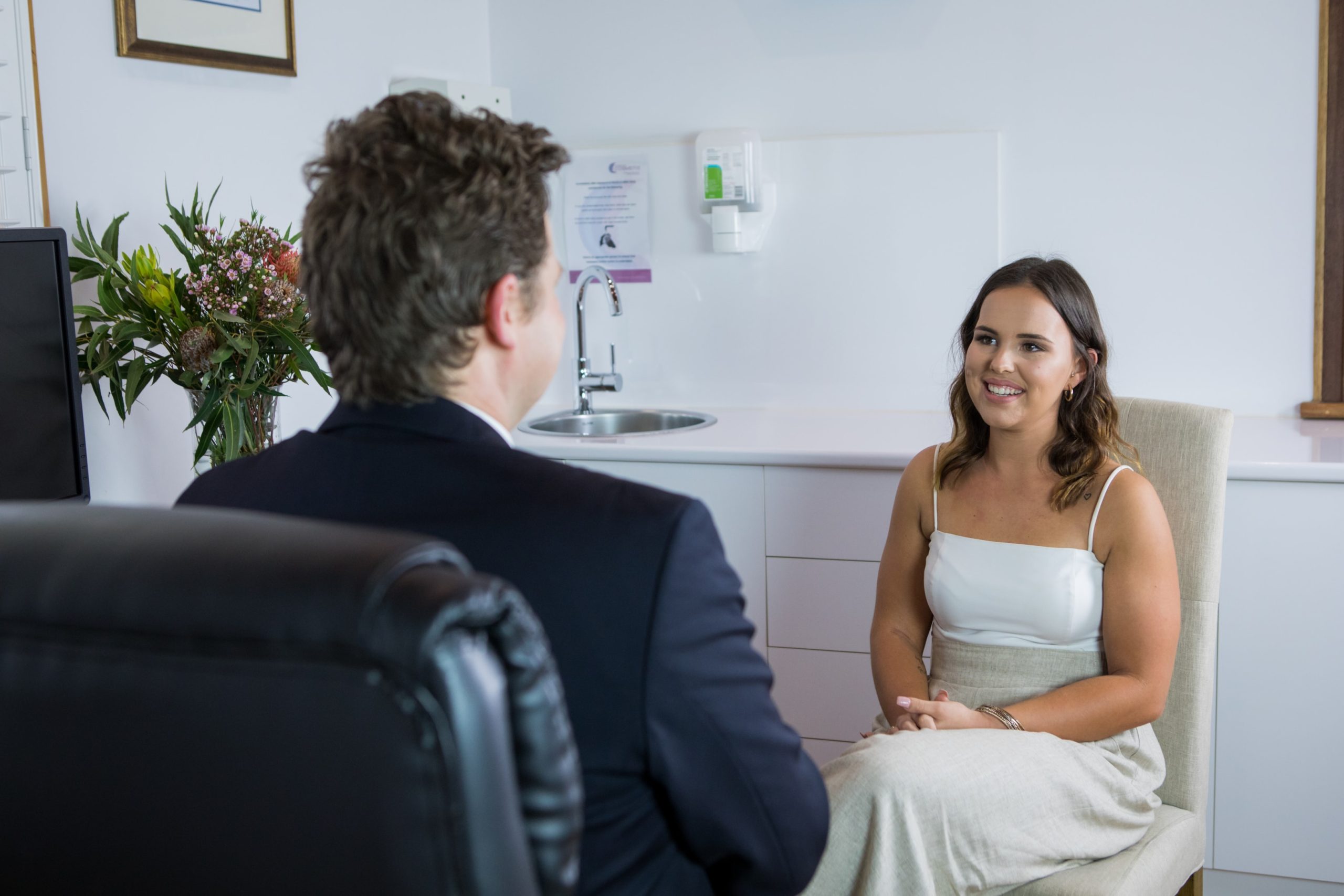
Pre-Surgery Consultation
The consultation is also the time to discuss your expectations, surgery limitations, and potential non-surgical options for scar reduction and stretch mark treatment.
Discuss your complete medical history and any medications and supplements you should start or stop before the surgery. Evaluate the clinic’s environment to ensure it meets your standards.
Certain lifestyle adjustments are crucial for optimising the successful outcome of your tummy tuck surgery. One of the most important changes is to stop smoking, as it can increase the risks associated with the surgery. Adopting such habits before surgery can significantly assist in your recovery.
I welcome you to book a consultation with me today so that we can have a one-on-one discussion about your goals, recovery, and everything in between.
Arranging Post-Surgery Support
Post-surgery support is as important as the surgery itself. You will need assistance with everyday tasks like household chores, pet and child care, driving, and carrying groceries. Organising help at home, whether from a family member, friend, or home health care aid can make a significant difference in your recovery process.
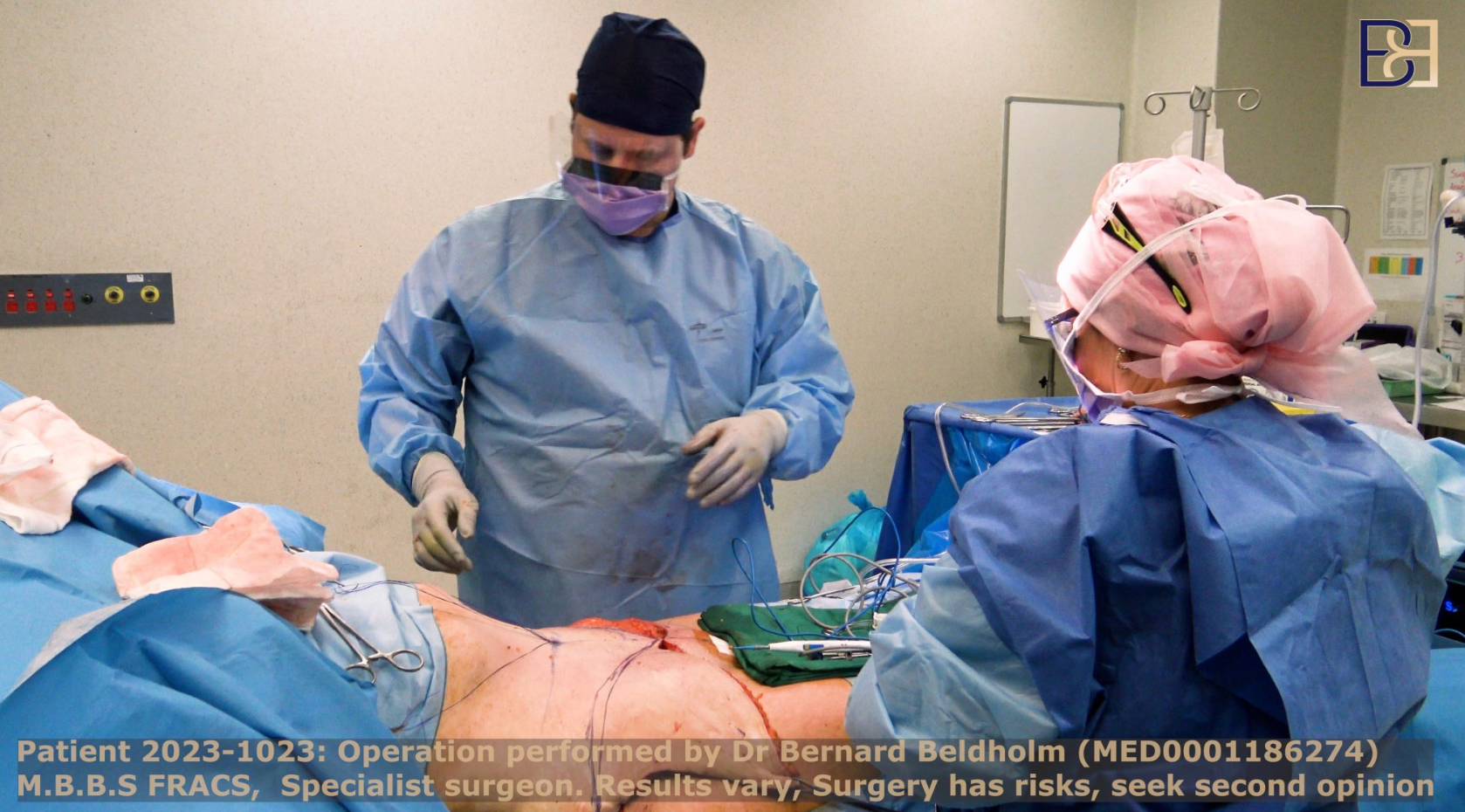
The Abdominoplasty Procedure
Taking the mystery out of the process is key to alleviating stress and maintaining a positive attitude, even in the rare event of a complication. Understanding the abdominoplasty procedure can help demystify the process and allow for realistic expectations.
A partial abdominoplasty focuses on removing excess skin and fat from the lower abdomen without repairing muscle separation. In contrast, a full abdominoplasty treats both excess skin and fat across the entire abdominal area and may involve muscle tightening.
What Happens During Cosmetic Surgery?
The abdominoplasty procedure is performed under general anesthesia, ensuring that patients do not feel or remember anything during the surgery. The procedure typically involves a hip-to-hip incision, although the exact style may vary based on the type of abdominoplasty being performed. Once the incision is made, the skin is separated from the underlying abdominal muscles to access and repair the abdominal wall, if necessary.
The surgery concludes with the closure of incisions using sutures, followed by the application of PICO negative-pressure wound bandage instead of a plain sterile bandage. PICO is a high-tech battery-powered apparatus that applies consistent negative pressure to the wound to aid in healing by keeping it contaminant-free while the incision heals.
Recovery After Abdominoplasty
Recovery is an integral part of the tummy tuck (Abdominoplasty) journey. Proper preparation and adherence to post-operative instructions can impact your recovery and results. Knowing what to expect during both the immediate and long-term recovery phases can help you navigate this period.
While the procedure does not prevent future weight gain, maintaining a healthy lifestyle post-surgery is crucial for preserving the results. Patients might experience discomfort, nausea, and excess fluid accumulation post-surgery, which are common aspects of the recovery process.
Immediate Post-abdominoplasty Surgery Care
Immediately after the abdominoplasty procedure, expect to feel tired, disoriented, and have a sore abdomen. Common post-surgery issues include bruising, swelling, and pain, which can be managed with prescribed pain medications. Most patients will spend a few nights in the hospital if they undergo a full abdominoplasty, while a mini abdominoplasty might allow for same-day discharge.
Compression garments play a vital role in the recovery process after an abdominoplasty. They help reduce swelling, provide support, and protect the wound during the first few weeks post-surgery.
Download our infographic: “15 Exercises to Try After Abdominoplasty”
Benefits of Wearing Compression Garments After Surgery
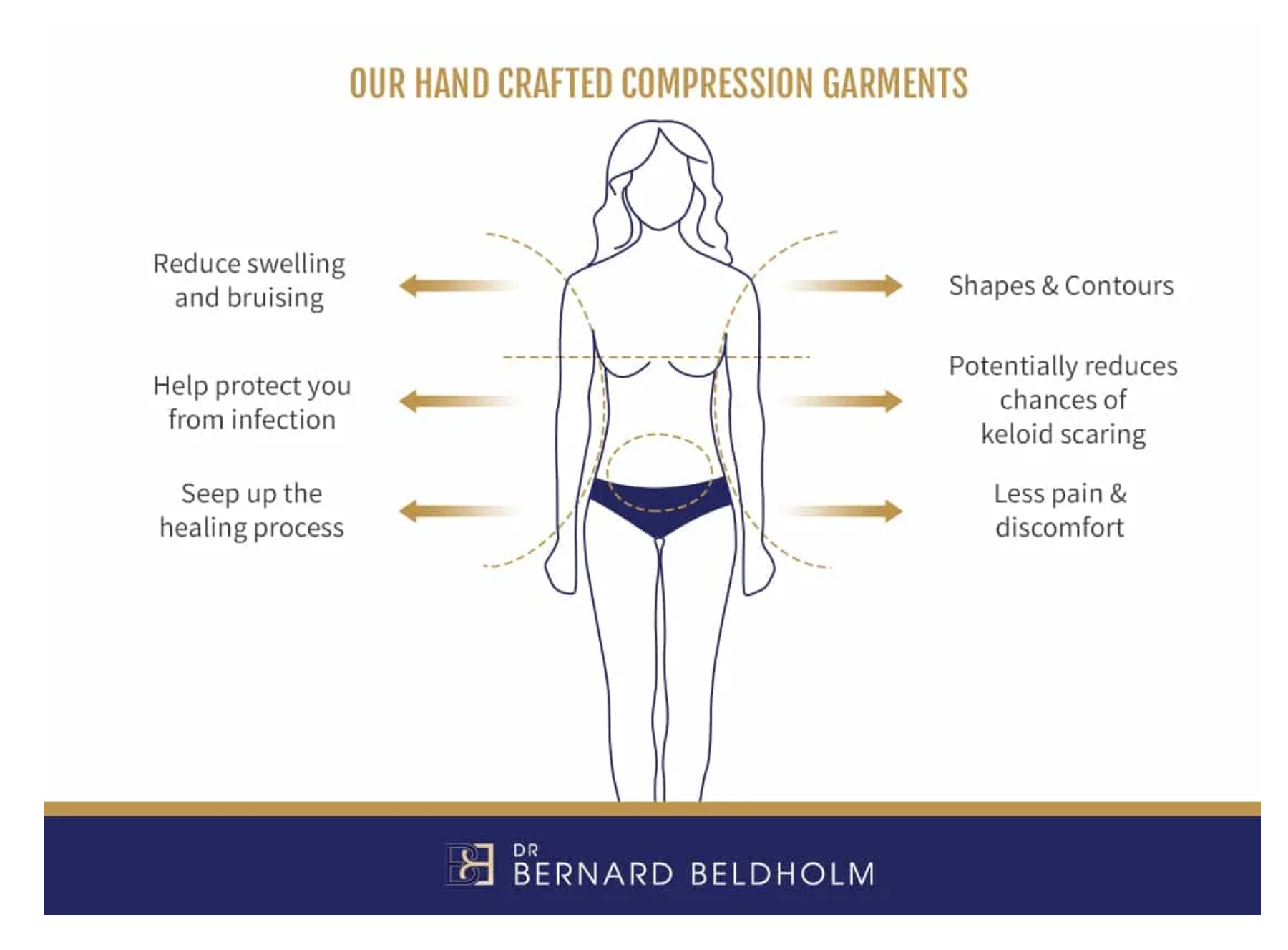
Compression garments serve many purposes to help aid your recovery after an abdominoplasty, lipo or body lift. Some of the key benefits include:
- Reduced swelling
- Lower risk of bruising and bleeding
- Speeds the healing process
- Shapes & contours
- Potentially reduced risk of keloid scarring
- Potentially Reduced infection risk
- Less pain & discomfort after surgery
Read more: How Long Do I Have to Stay in the Hospital After Abdominoplasty Surgery? – What You Need to Know
Long-Term Recovery Process
The long-term recovery process for a tummy tuck (Abdominoplasty) can last between 4 to 8 weeks. Having a trusted individual to assist you during the initial recovery days is crucial. Following your provider’s recommendations for pain management, taking antibiotics, and wearing compression garments are essential for promoting proper healing and preventing poor wound healing.
Most patients can return to light work within one to three weeks, but strenuous activities should be avoided for several weeks post-surgery. Avoid strenuous activities and lifting heavy objects until you get the all-clear from your surgeon.
Following post-operative care instructions, such as managing pain, caring for the incision site, and gradually resuming normal activities, is crucial for achieving success. Wearing a compression garment continuously for the initial weeks post-surgery supports the healing process and reduces swelling.
Read More: Recovery Following Abdominoplasty Surgery

What to Look for in a Surgeon
Finding a qualified medical practitioner to perform your abdominoplasty is critical. Here are some of the important attributes of a qualified surgeon.
- Experience: When choosing a surgeon, look for someone who has experience in performing abdominoplasty procedures.
- Reputation: Your surgeon should also have a good reputation, and be willing to answer any questions you may have. Read reviews and ask for before and after photos of past patients.
- Comforting: It is essential to feel comfortable about your surgeon’s abilities. A good surgeon will take the time to review your concerns about your appearance and answer your questions about the surgery, risks, recovery, realistic expectations and scarring.
- Specialist Surgeon: A specialist surgeon in Australia has the post-nominal FRACS. This stands for Fellow of the Royal Australasian College of surgeons. Surgeons from the Royal Australasian College of Surgeons (RACS) are highly trained and undergo five or six years of surgical training that is certified by the Australian Medical Council (AMC) or Medical Council of New Zealand (MCNZ). This training is in addition to their medical degree and pre-vocational training in a hospital.

Cost Considerations for Abdominoplasty
The cost of an abdominoplasty can vary widely based on several factors, including the surgeon’s fees, anesthesia, and hospital costs. In Australia, the price range typically falls between $15,000 and $24,000. It’s crucial to get a detailed estimate during your consultation, which should cover all associated fees.
Read more: “What is the Average Cost of Abdominoplasty (Tummy Tuck) Surgery in Australia in 2024?”
Dr. Beldholm’s Final Thoughts

Understanding the different types of abdominoplasty to preparing for surgery and navigating the recovery process, being well-informed is crucial for a successful outcome. It’s also important to consider the costs, potential risks, and how to choose a qualified surgeon.
As you contemplate this significant surgery, remember that the journey doesn’t end at the operating table. Proper preparation, realistic expectations, and a commitment to a lifestyle that is conducive to wellness post-surgery are essential for long-lasting results.
FAQs
Can I undergo an abdominoplasty if I’ve had previous abdominal surgery?
Yes. One can still get a abdominoplasty after previous abdominal surgery. Just make sure to chat with your surgeon about your medical history so they can plan it right for you.
Do I need to wear compression garments 24/7?
After surgery, many surgeons recommend wearing the garment day and night for the first 4 weeks, except to shower. Of course, this can vary depending on the exact procedure and extent of surgery. During the second phase of recovery (usually weeks 4-6), you may only need to wear the garment during the day.
What are the potential complications of abdominoplasty?
As with any surgery or other operation, there are always potential risks and complications. Discussing them with your surgeon can help mitigate potential complications and ease your mind.
More concerning complications following abdominoplasty include cardiac issues, serious wound infection, deep vein thrombosis (blood clots forming in the legs or lungs), and healing difficulties that might require further surgery. Minor complications can include hematoma, skin discolouration, swelling, and healing issues at the surgical site. Visible and prominent scars as well as changes in skin sensations, such as numbness, can also occur.
Book your appointment online now
References
- Impact of surgical consultation on outcomes in hemodynamically supported High-Risk percutaneous Coronary Intervention: insights from PROTECT II randomised study. (2016, May 1).
- Kahramanca, Ş., Kaya, O., Azılı, C., Güzel, H., Özgehan, G., & İrem, B. (2013). The role of general surgery consultations in patient management. Turkish Journal of Surgery/Ulusal Cerrahi Dergisi, 29(1), 20-24.
- Thilen, S. R., Woersching, A. L., Cornea, A. M., Lowy, E., Weaver, E. M., & Treggiari, M. M. (2018). Surgical speciality and preoperative medical consultation based on commercial health insurance claims. Perioperative Medicine, 7.
- Sorensen, M. J., Bessen, S., Danford, J., Fleischer, C., & Wong, S. L. (2020). Telemedicine for Surgical Consultations – Pandemic Response or Here to Stay?: A Report of Public Perceptions. Annals of Surgery, 272(3), e174.
- Chowdhry, S., Davis, J., Boyd, T., Choo, J., Brooks, R. M., Kelishadi, S. S., Tutela, J. P., Yonick, D., & Wilhelmi, B. J. (2015). Safe Tummy Tuck: Anatomy and Strategy to Avoid Injury to the Lateral Femoral Cutaneous Nerve During Abdominoplasty. Eplasty, 15.
- Egnew TR, Wilson HJ. Role modelling the doctor-patient relationship in the clinical curriculum. Family Medicine. 2011;43:99–104.
- Auerbach AD, Rasic MA, Sehgal N, Ide B, Stone B, Maselli J. Opportunity missed: medical consultation, resource use, and quality of care of patients undergoing major surgery. Arch Intern Moed. 2007;167(21):2338–2344.
- Katz R, Cimino L, Vitkun S. Preoperative medical consultations: impact on perioperative management and surgical outcome. Can J Anaesth. 2005;52(7):697–702.

